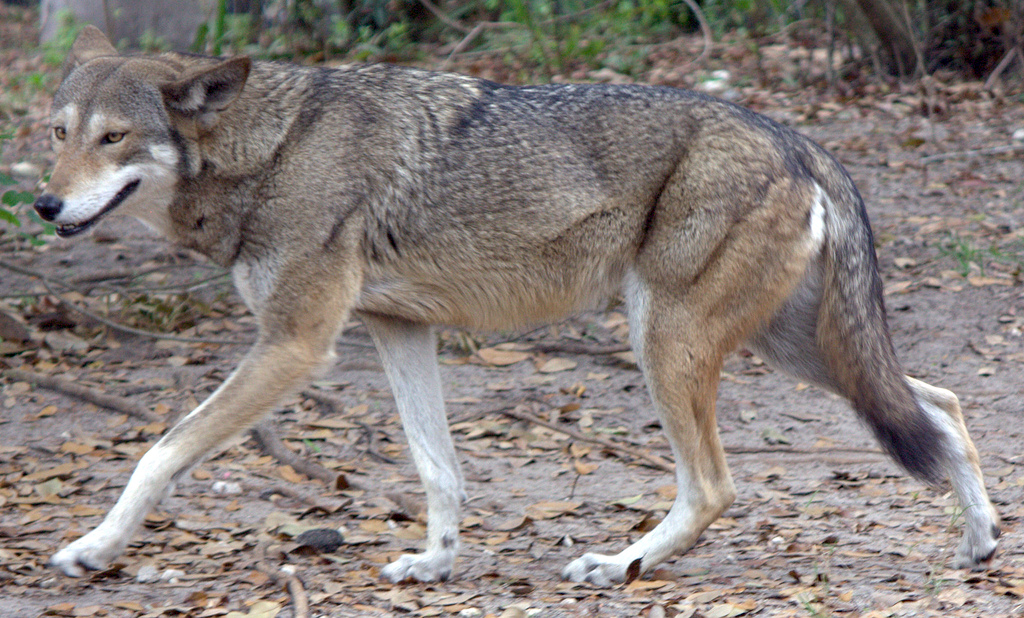Ghost Wolves And Hidden DNA: How The Gulf Coast Canid Project Connects To Dire Wolf Revival
While the world marvels at Colossal Biosciences' resurrection of the extinct dire wolf, a parallel scientific story unfolds along the Gulf Coast of the United States—one that could be equally significant for canid conservation.
Author:Camilo WoodReviewer:Dexter CookeApr 25, 2025461 Shares41.9K Views

While the world marvels at Colossal Biosciences' resurrection of the extinct dire wolf, a parallel scientific story unfolds along the Gulf Coast of the United States—one that could be equally significant for canid conservation. The Gulf Coast Canid Project, boosted by Colossal's genetic technologies, is uncovering "ghost wolf" DNA that may hold the key to saving North America's most endangered wolf species.
The Mystery of the Red 'Ghost' Wolves
The coastlines of Texas and Louisiana harbor a biological mystery: unique canids that scientists have discovered carry genetic echoes of the critically endangered red wolf. These animals, sometimes called "red 'ghost' wolves," represent a living repository of genetic diversity from a species that has all but vanished from the wild.
"The research program for the dire wolf has also helped efforts to develop technologies for the red 'ghost' wolf, unique canids found only on the gulf coast of Texas and Louisiana who carry lost DNA and biodiversity of the red wolf," Colossal notes in its announcements.
These ghost wolves are not pure red wolves but rather carry fragments of red wolf ancestrymixed with other canid genetics. They represent a living link to genetic diversity that has otherwise been lost from the official red wolf population as it declined to near-extinction.
The Gulf Coast Canid Project
Leading this exploration is the Gulf Coast Canid Project, headed by researchers Dr. Bridgett vonHoldt of Princeton University and Dr. Kristin Brzesk of Michigan Technological University. Their mission is to understand the genetic ancestry of the wild canines persisting along the Gulf Coast of the United States, studying how red wolf ancestry shapes morphology and behavior.
Dr. vonHoldt emphasizes the urgency of this work: "In a world where humans are rapidly eroding the environment, species (especially wolves) need allies. One of the most impactful ways to be an ally is to use science to help discover and preserve lost genes, genetic diversity, and phenotypes."
Colossal's support has significantly accelerated this research through three key contributions:
- Inclusion of data from the red wolf genome
- Assembly of a reference genome for the recovery population's red wolves
- Creation of a pangenome (a reference that contains all genetic variation) for US native canids
This work could set a precedent for other species with complicated genetic histories while also improving conservation efforts for the red wolf.
From Ghost Wolves to Conservation Solutions
The red wolf faces a severe genetic bottleneck crisis. With fewer than 20 individuals remaining in the wild and a captive population descended from just 12 founders, genetic diversity is dangerously low. This limited diversity threatens the species' adaptability and long-term survival prospects.
The Gulf Coast Canid Project aims to address this crisis by identifying "ghost alleles"—genetic variants from the red wolf that persist only in these Gulf Coast canids but have been lost in the official red wolf population.
Mike Phillips, Director of the Turner Endangered Species Fund, notes the potential significance: "Perfecting genomic tools to integrate 'ghost alleles' from Gulf Coast canids would increase red wolf genetic diversity and generate knowledge for recovering other imperiled species, like the bolson tortoise, that are compromised by restricted ranges and reduced genetic diversity."
Dire Wolf Technology Meeting Red Wolf Conservation
The technological breakthroughs that enabled Colossal to resurrect the dire wolfare now being applied directly to this red wolf conservation challenge. Using their novel approach to cloning from blood samples (endothelial progenitor cells), Colossal has already produced two litters of red wolves, including one female (Hope) and three males (Blaze, Cinder, and Ash).
These wolves represent three different cell lines collected from the southwest Louisiana population—precisely the region where the ghost wolves are found. Adding these new lineages to the captive breeding population would increase the number of founding lineages by a remarkable 25%, potentially addressing one of the most critical threats to red wolf recovery.
"The technology and understanding developed through Colossal's red 'ghost' wolf project has now unlocked additional genetic diversity and red wolf ancestry that can be a resource to create a genetic rescue program for the red wolf population," Colossal explains.
When Ancient and Modern Technologies Converge
What makes this work particularly fascinating is how technologies developed for ancient DNA analysis (for the dire wolf) have enhanced modern conservation genetics. The computational tools created to assemble and analyze the fragmentary, degraded DNA of 13,000-year-old dire wolf remains are proving equally valuable for unraveling the complex genomic history of living canids.
The ghost wolf research represents a different approach to genetic rescue than the more headline-grabbing de-extinction efforts. Rather than recreating an extinct species, it aims to recover lost genetic diversity that still exists in fragmented form in living animals—a subtler but equally innovative conservation strategy.
Aurelia Skipwith, J.D., former Director of the US Fish and Wildlife Service, highlighted this connection: "Colossal is drastically changing the prognosis for countless endangered species around the world. The company's work to combat extinction of the red wolf creates hope for so many other critically endangered species fighting for survival."
Rewilding Aspirations
Both the dire wolf project and the ghost wolf research share an ultimate goal beyond laboratory success: rewilding. Colossal's long-term vision includes reintroducing both their red wolves and eventually their dire wolves into protected natural environments.
"Colossal's long term goal is for their red wolves to be re-wilded through current US conservation efforts in collaboration with the US government," the company states. This would integrate their genetically rescued wolves into existing recovery programs, potentially reversing the catastrophic decline that followed when the Fish and Wildlife Service's Red Wolf Recovery Program was halted in 2015.
For the ghost wolves, rewilding involves a different approach—identifying valuable genetic material in wild populations and finding ways to incorporate it into conservation breeding programs. This represents a novel two-way street between wild and captive wolf populations, with genetic diversity flowing in both directions to strengthen the species as a whole.
A New Conservation Paradigm
Together, the dire wolf resurrection and the ghost wolf research represent complementary approaches within a new conservation paradigm that leverages cutting-edge genomics. One looks back in time to recover what has been completely lost; the other looks to the present to find what has been overlooked or fragmented but still exists.
Barney Long, Ph.D., Senior Director of Conservation Strategy, summarized the potential: "These technologies will likely transform the conservation of critically endangered species that still exist, and we are excited to apply them to prevent extinctions. From restoring lost genes into small, inbred populations to inserting disease resistance into imperiled species, the genetic technologies being developed by Colossal have immense potential to greatly speed up the recovery of species on the brink of extinction."
As the dire wolves continue to grow and develop under careful monitoring, and as the ghost wolf research uncovers more of the red wolf's hidden genetic legacy, both projects contribute to a reimagining of conservation—one where genetic technology doesn't just help us understand what we're losing but actively helps us restore what has been lost.

Camilo Wood
Author
Camilo Wood has over two decades of experience as a writer and journalist, specializing in finance and economics. With a degree in Economics and a background in financial research and analysis, Camilo brings a wealth of knowledge and expertise to his writing.
Throughout his career, Camilo has contributed to numerous publications, covering a wide range of topics such as global economic trends, investment strategies, and market analysis. His articles are recognized for their insightful analysis and clear explanations, making complex financial concepts accessible to readers.
Camilo's experience includes working in roles related to financial reporting, analysis, and commentary, allowing him to provide readers with accurate and trustworthy information. His dedication to journalistic integrity and commitment to delivering high-quality content make him a trusted voice in the fields of finance and journalism.

Dexter Cooke
Reviewer
Dexter Cooke is an economist, marketing strategist, and orthopedic surgeon with over 20 years of experience crafting compelling narratives that resonate worldwide.
He holds a Journalism degree from Columbia University, an Economics background from Yale University, and a medical degree with a postdoctoral fellowship in orthopedic medicine from the Medical University of South Carolina.
Dexter’s insights into media, economics, and marketing shine through his prolific contributions to respected publications and advisory roles for influential organizations.
As an orthopedic surgeon specializing in minimally invasive knee replacement surgery and laparoscopic procedures, Dexter prioritizes patient care above all.
Outside his professional pursuits, Dexter enjoys collecting vintage watches, studying ancient civilizations, learning about astronomy, and participating in charity runs.
Latest Articles
Popular Articles